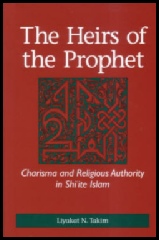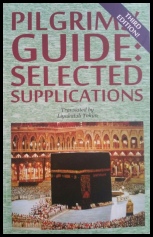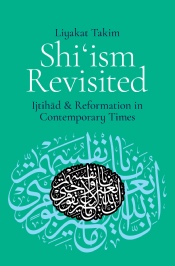Dr. Liyakat Takim
Sharjah Chair in Global Islam
McMaster University, Religious Studies
University Hall, Room 116
1280 Main Street West
Hamilton, Ontario Canada, L8S 41
The Heirs of the Prophet: Charisma and Religious Authority in Shi‘ite Islam.
By Dr Liyakat Takim
ISBN 0-7914-6737-6
Albany: State University of New York, 2006.
Buy Now! ISBN: 0791467384
https://www.amazon.com/Heirs-Prophet-Charisma-Religious-Authority/dp/0791467376
Summary
2007 CHOICE Outstanding Academic Title
Looks at how various factions used the tradition that scholars were the “heirs of the Prophet” during the classical period of Islam (570–1258 CE).
After the death of the Prophet Muhammad, different religious factions within the Muslim community laid claim to the Prophet’s legacy. Drawing on research from Sunni and Shiite literature, Liyakat N. Takim explores how these various groups, including the caliphs, scholars, Sufi holy men, and the Shiite imams and their disciples, competed to be the Prophetic heirs. The book also illustrates how the tradition of the “heirs of the Prophet” was often a polemical tool used by its bearers to demand obedience and loyalty from the Muslim community by imposing an authoritative rendition of texts, beliefs, and religious practices. Those who did not obey were marginalized and demonized. While examining the competition for Muhammad’s charismatic authority, Takim investigates the Shiite self-understanding of authority and argues that this was an important factor in the formation of a distinct Shiite leadership. The Heirs of the Prophet also provides a new understanding of textual authority in Islam by examining authority construction and the struggle for legitimacy evidenced in Islamic biographical dictionaries.
“This book is very well written and demonstrates a vast knowledge and intimate familiarity with both primary and secondary sources on the topic of the Shiite imams and their deputies. Takim’s exploration of how authority was constructed and made legitimate in early Shiite biographies, exegeses, legal theories, kalam, and the like, forges new ground in the field.” — Kathryn Kueny, author of The Rhetoric of Sobriety: Wine in Early Islam
Liyakat N. Takim is Associate Professor of Islamic Studies at the University of Denver.
Introduction
Liyakat Takim
The Heirs of the Prophet: Charisma and Religious Authority in Shi‘ite Islam. ISBN: 0791467384
“The scholars are heirs to the prophets” is a famous tradition that has been reported from the Prophet Muhammad. When I examined the provenance and deployment of this tradition in the classical period of Islam (570 – 1258 C.E.), I realized that the title “heirs of the Prophet” was more than an honorific epithet. As scholars belonging to different factions contested the right to assume the title, it was obvious that the exclusivist claims to be the heirs of the Prophet reflected a wider struggle within the Muslim community to wield prophetic prestige through demonstrations of authority, which were based on the Prophet’s legacy.
The “heirs tradition” as it was called, also became a polemical tool that could be and was used by its bearers to wrestle authority from competing factions. The deployment of the “heirs tradition” extended beyond excluding scholars, who belonged to other factions, from legitimating and exercising authority in the Muslim community. It also was used to impose authoritative and exclusivist rendition of texts, beliefs, and religious practices.
This study explores how different religious factions within the Muslim community competed to be the heirs of the Prophet, and demonstrates the interplay between power and knowledge and the ensuing tensions among these factions. My exploration of the classical texts seeks to uncover and elaborate the methods and strategies employed by the learned class, as well as other groups, to wield and legitimize authority on behalf of the Prophet.
My investigation into the different groups’ self-understanding of post-Muhammadan authority and the struggle for legitimacy is predicated on a textual, phenomenological, and chronological approach to the study and interpretation of juridical, biographical, heresiographical, hagiographical, exegetical, and polemical texts. I also examine how various groups made use of hermeneutical tools in constructing authority and vindicating their claims to be the exclusive heirs of the Prophet.
A number of recent studies have tackled the question of authority in Islam. For instance, Hamid Dabashi has written on the general notion of authority in Islam while Sa‘id Arjomand and Abdulaziz Sachedina have focused on the authority of the jurists in the post-ghayba (940 C.E.) period in Shi‘i Islam. The works of Patricia Crone, Martin Hinds, and Muhammad Qasim Zaman examine the struggle for authority between the caliphs and Sunni scholars. My study goes beyond their work in that it fills the lacuna of inquiry into the struggle for authority between and within the disparate groups that claimed to be the heirs of the Prophet. The project also treads new ground by examining the impact of the juxtaposition of different genres of authority in the Shi‘i community during the times of the imams.
My discussion of how the “heirs tradition” shaped and molded leadership and other related institutional structures in the classical period of Islam is couched within the framework of the models of charismatic leadership postulated by Max Weber (1862-1920). In attempting to locate an Islamic equivalent of Weber’s tripartite typology of the modes of authority (rational-legal, traditional, and charismatic), in chapter one I discuss Weber’s characterization of charismatic authority, and contrast this with the genres of authority dominant in pre-Islamic Arabia. I then examine the exercise of authority in the post-Muhammadan era by deploying Weber’s typology of the routinization of charismatic leadership in the establishment of the charisma of office.
After the death of Muhammad, the discussion of authority was soon cast under the designation “heirs of the Prophet.” The first chapter of this study goes on to, therefore, examine the ramifications of claiming to be the “heirs of the Prophet,” the emergence of the scholarly elite as the sole careers of religious knowledge, and the struggle for authority that ensued among scholars and their followers in different groups. While examining the competition for Muhammad’s charismatic authority after his death, I investigate the Shi‘i self-understanding of authority and argue that this was an important factor in the formulation of a distinct Shi‘i leadership founded upon its legal system.
Using the conceptual framework postulated by Rudolf Otto, I trace the emergence of the holy man in Islam and the type of authority that he wielded in the Muslim community in the second chapter. This chapter also contrasts Sufi and Shi‘i variations in the conceptualization of the holy men and examines the methods through which the holy men validated their claims to spiritual authority. I also compare and contrast the authority wielded by the jurists and holy men. Whether it is acquired or inherited, the charisma of the holy man is in contradistinction to the charisma of office as defined by the jurists.
A largely unexplored dimension of religious authority in Islam is the routinization of charismatic authority in Shi‘ism during the presence of the imams. In my discussion on post-Muhammadan authority, I argue that Shi‘ism in the eighth century manifests a major variation from the traditionally accepted, Weberian understanding of the rise of routinized charisma. In chapters three and four, I extend my discussion of authority and the “heirs traditions” to include the deputies of the Shi‘i imams.
My interest in the disciples of the imams, the rijal, was initially kindled during my study in Qum, Iran, in 1983-85. I heard then that a prominent scholar, Ja‘far al-Subhani, had been delivering lectures on the study of the biographical profiles of the rijal. When I attended his lectures, I realized not only the depth of the subject but also the paucity of research on the rijal among contemporary western scholars.
Chapter three contends that the delegation of the imams’ authority to their close associates was an important landmark in Shi‘i history insofar as it signified a transition from the centralized, universal, charismatic authority of the imams to a more structured and regionalized charismatic office of the rijal. In the process of divesting their authority to their close disciples, the imams were routinizing their charismatic authority and diffusing their charisma into a newly emerging symbiotic structure. I examine how the affirmation of the charismatic office of the imams’ prominent disciples and “heirs” to their knowledge interacted with and often militated against the absolute nature of the imam’s charismatic authority.
In the fourth chapter, I examine how the authority of the disciples of the imams evolved and was enhanced in the very functions they performed. The chapter delineates the various activities of the rijal, and contends that these were highly significant in asserting a divergent concept of religious authority in the Muslim community. I also argue that, by performing various activities in the office of charisma, the rijal constructed a normative basis or a “sectarian syndrome” through which “orthodox” views and beliefs could be distilled and differentiated from those espoused by their opponents. An important consequence of this process of establishing “orthodoxy” was the accentuation of the authority of the rijal and the construction of boundaries of identity and exclusion.
The chapter goes on to demonstrate that, as agents of the imams, the rijal also established paradigmatic precedents in various fields, which subsequent Shi‘is could emulate. The “living sunna,” which was generated by the paradigmatic activities of the rijal, was incorporated into the Shi‘i canonical tradition that crystallized in the ninth and tenth centuries.
The fifth and final chapter explains how later biographers, faced with contradictory appraisals of important personages, on the one hand, and the need to depict an idealized image of them, on the other, encountered, grappled, and finally shaped the authoritative images of those individuals. I demonstrate that Shi‘i biographers were engaged in hermeneutical activity and a textual enterprise that evolved into an increasingly restrictive interpretation and canonical evaluation of the disciples of the imams. The appraisals of the biographers laid claim to an exclusivist hermeneutic and became sufficiently entrenched to impose an authoritarian evaluation on those they profiled. The chapter also offers evidence of a different and radical form of idealization in later Shi‘i biographical literature.
In the second section of this chapter, I compare and contrast Sunni and Shi‘i profiles of two important Shi‘i disciples of the imams, demonstrating the tussle for authority and the struggle for legitimacy that is evinced in the biographical texts. By comparing Sunni and Shi‘i biographical literature, my book adds a new dimension to the questions of textual authority and hermeneutical enterprises in Islamic biographical dictionaries. Such an approach should lead scholars to consider new ways of understanding the function of sacred texts within the communities that engage and appropriate them for developing a charismatic authority and a sense of loyalty to it.
The Heirs of the Prophet: Charisma and Religious Authority in Shi‘ite Islam. ISBN: 0791467384
Other Reviews
- http://www.worldcat.org/title/heirs-of-the-prophet-charisma-and-religious-authority-in-shiite-islam/oclc/470150506
- Takim, Liyakat N. The heirs of the prophet: charisma and religious authority in Shi'ite Islam. State University of New York, 2006. 236p bibl index afp ISBN 0-7914-6737-6, $65.00. Reviewed in 2007mar CHOICE. This is a most important study. Takim (Univ. of Denver) is unafraid of controversial sources, freely citing erudite but marginalized scholars such as Patricia Crone and Martin Hinds while basing a portion of his analysis on the trailblazing contribution of Hamid Dabashi (Authority in Islam, CH, May'90, 27-5096). In so doing, Takim gives a comprehensive, multifaceted view of the Shi'ites: clearly, this is not merely Dabashi redux. Unafraid of coining terms ("shari' men," for example), Takim offers a treatment of Twelver Shi'ism that is at times sympathetic, but not uncritical. Almost magically, he bridges many of the gaps, real and imagined, between Sunni and Shi'i Islam without glossing over the real differences dividing these two Islamic viewpoints. In this endeavor, Takim does not necessarily toe the traditional lines in his discussions; for example, his thoughts on the early relations between caliphs and scholars have a logic of their own without being a mere restatement of "orthodoxy," be it Orientalist or otherwise. He also searches for the locus of authority not only in the persons of the Shi'ite hierarchy but also within the texts of Shi'ite Islam, paying special attention to the biographers. This is a creative work from a creative thinker. Summing Up: Highly recommended. Upper-level undergraduates and above. -- S. P. Blackburn, Hartford Seminary
- Religious Studies Review
Volume 34 Issue 2 Page 117-117, June 2008
To cite this article: Christopher Anzalone (2008) THE HEIRS OF THE
PROPHET: CHARISMA AND RELIGIOUS AUTHORITY IN SHI'ITE ISLAM - By Liyakat N.
Takim
Religious Studies Review 34 (2) , 117-117 doi:10.1111/j.1748-0922.2008.00276_4.x
THE HEIRS OF THE PROPHET: CHARISMA AND RELIGIOUS AUTHORITY IN SHI'ITE ISLAM - By Liyakat N. Takim
* Christopher Anzalone11Indiana University, Bloomington
1Indiana University, Bloomington
THE HEIRS OF THE PROPHET: CHARISMA AND RELIGIOUS AUTHORITY IN SHI'ITE ISLAM. By Liyakat N. Takim Albany
: State University of New York Press, 2006. Pp. xiv + 236; $65, ISBN 978-0-7914-6737-4.
Takim's first book, which is based on his doctoral dissertation at the School of Oriental and African Studies at the University of London, is a welcome addition to the available studies on early and medieval Shi'ism as well as the debates over religious authority during Islam's formative centuries. Referencing foundational Shi'i biographical and Ahadith texts, he analyzes the development of the authority of Muslim theologians
("ulama") as successors to the Prophet Muhammad through the lens of Weber's description of charismatic religious leadership. Takim argues that the Sunni understanding of the juridical authority of their religious scholars is based on historical developments over the centuries whereas the Twelver Shi'a trace the charismatic authority of their religious leaders directly to that of Muhammad through the line of the Imams.
Competing factions, from the Sunni Umayyad and 'Abbasid caliphs to the Shi'i imams and the Sufi mystics, all claimed to be the rightful heirs to Muhammad's legacy and charismatic authority. In so doing, they sought to counter and delegitimize their opponents while supporting their own claims to religious leadership. Takim argues that due to increasing pressures during the late Umayyad and 'Abbasid periods the later Shi'i imams were forced to diffuse religious knowledge and charismatic authority to their most learned students and disciples. In turn, these men (rijal) were believed to have been imbued with the charismatic authority of Muhammad himself. Later, Shi'i biographical and juridical works further enhanced the nature of their stature. Takim has provided a much-needed study of the development of sectarian and factional debates and infighting that has played such a prominent role in Islamic history. His book will be of great use to scholars and graduate students with prior background in Islamic studies who are seeking to understand the complex debates over religious authority and succession to Muhammad. It would also be an ideal choice for graduate level seminars in Islamic history, theological texts, Shi'ism, and religious authority.
Guide to Ziyaraat:
Selected Supplications (Translation)
Contains all the major Ziyarat in Iran, Iraq and Syria. The book also provides historical details of some companions of the Prophet and the Imams. Arabic text with English translations.
This pocket-size book is a very important companion for all going for ziyarat. It contains all the ziyarat in Iraq, Iran, and Syria. Besides containing the ziyarat (in Arabic with English translation) of the infallible ones, this book also outlines the historical lives of some notable companions of the Prophet and the Imams (peace be upon all of them). The ziyarat of some of these companions have also been included in this book.
Shi’ism Revisited: By Dr. Liyakat Takim
“Shi'i Revisited: Ijtihad and Reformation in Contemporary Times” assesses the possibility of an Islamic reformation in contemporary Shi’ism. It also examines the process and methods of ijtihad in deriving a fatwa, the moral basis of Islamic law, and proposes epistemological and methodological changes so as to make Islamic law more moral and viable for contemporary times. A must read for anyone interested in Islamic law in modern times.
The book will be published by Oxford University Press in January 2022
To Purchase book
https://global.oup.com/academic/product/shiism-revisited-9780197606575?lang=en&cc=bg
Additional information
https://global.oup.com/academic/product/shiism-revisited-9780197606575?lang=en&cc=ca
Ijtihad and Reformation in Contemporary Times
Liyakat Takim
Shows how centuries-old Islamic law can be reformulated for the contemporary world
Examines practical issues from women's rights to bioethics and the challenges facing diasporic Muslims
Discusses the intersection between ethics and Islamic Reformation

















